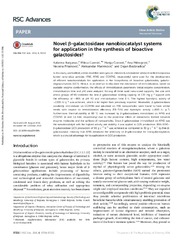Приказ основних података о документу
Novel β-galactosidase nanobiocatalyst systems for application in the synthesis of bioactive galactosides
| dc.creator | Banjanac, Katarina | |
| dc.creator | Simović, Milica | |
| dc.creator | Ćorović, Marija | |
| dc.creator | Milivojević, Ana | |
| dc.creator | Prlainović, Nevena | |
| dc.creator | Marinković, Aleksandar | |
| dc.creator | Bezbradica, Dejan | |
| dc.date.accessioned | 2021-03-10T13:05:06Z | |
| dc.date.available | 2021-03-10T13:05:06Z | |
| dc.date.issued | 2016 | |
| dc.identifier.issn | 2046-2069 | |
| dc.identifier.uri | http://TechnoRep.tmf.bg.ac.rs/handle/123456789/3298 | |
| dc.description.abstract | In this study, unmodified, amino modified and cyanuric chloride functionalized amino modified nonporous fumed nano-silica particles (FNS, AFNS and CCAFNS, respectively) were used for the development of efficient nanobiocatalysts for application in the biosynthesis of bioactive galactosides, galacto-oligosaccharides (GOS). Hence, in an attempt to elucidate the mechanism of immobilization, based on available enzyme conformation, the effects of immobilization parameters (initial enzyme concentration, immobilization time and pH) were analyzed. Among all three used nano-sized supports, the one with amino groups (AFNS) exhibited the best beta-galactosidase binding capacity of 220 mg g(-1) support with the efficiency of similar to 90% at pH 4.5 and immobilization time 3 h. The highest hydrolytic activity of similar to 2200 IU g(-1) was achieved, which is far higher than previously reported. Meanwhile, beta-galactosidases covalently immobilized on CCAFNS and adsorbed on FNS nanoparticles were found to have similar trends with respect to immobilization efficiency (58-71%) and hydrolytic activity (similar to 600 IU g(-1)). Furthermore, thermal stability at 60 degrees C was increased by beta-galactosidases immobilized on AFNS and CCAFNS (4 and 1.4-fold, respectively) due to the protective effect of interactions formed between enzyme molecules and the surfaces of nanoparticles. Since b-galactosidase immobilized on AFNS was the nanobiocatalyst with the highest activity and stability, it was applied in GOS production. With AFNS- beta-galactosidase GOS production of 90 g L-1 h(-1) was achieved as compared to 30 g L-1 h(-1) by free beta-beta-galactosidase, meaning that AFNS enhanced the selectivity of b-galactosidase for transgalactosylation, which is a crucial advantage for its application in GOS production. | en |
| dc.publisher | Royal Society of Chemistry | |
| dc.relation | info:eu-repo/grantAgreement/MESTD/Integrated and Interdisciplinary Research (IIR or III)/46010/RS// | |
| dc.relation | info:eu-repo/grantAgreement/MESTD/Basic Research (BR or ON)/172013/RS// | |
| dc.relation | info:eu-repo/grantAgreement/MESTD/Integrated and Interdisciplinary Research (IIR or III)/45019/RS// | |
| dc.rights | openAccess | |
| dc.rights.uri | https://creativecommons.org/licenses/by-nc/4.0/ | |
| dc.source | RSC Advances | |
| dc.title | Novel β-galactosidase nanobiocatalyst systems for application in the synthesis of bioactive galactosides | en |
| dc.type | article | |
| dc.rights.license | BY-NC | |
| dc.citation.epage | 97225 | |
| dc.citation.issue | 99 | |
| dc.citation.other | 6(99): 97216-97225 | |
| dc.citation.rank | M22 | |
| dc.citation.spage | 97216 | |
| dc.citation.volume | 6 | |
| dc.identifier.doi | 10.1039/c6ra20409k | |
| dc.identifier.fulltext | http://TechnoRep.tmf.bg.ac.rs/bitstream/id/1226/3295.pdf | |
| dc.identifier.scopus | 2-s2.0-84991730114 | |
| dc.identifier.wos | 000386242500095 | |
| dc.type.version | publishedVersion |

